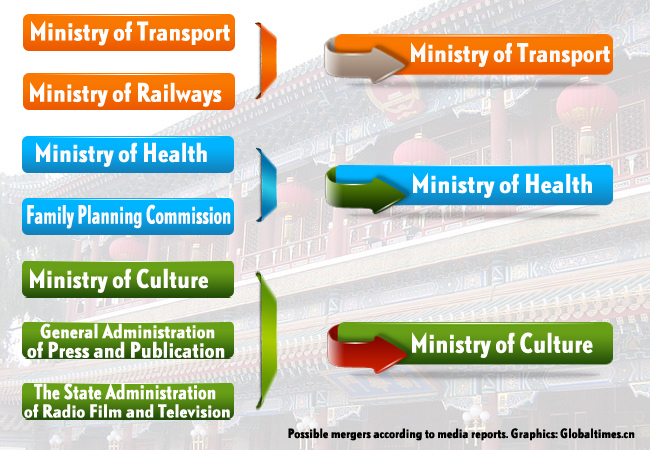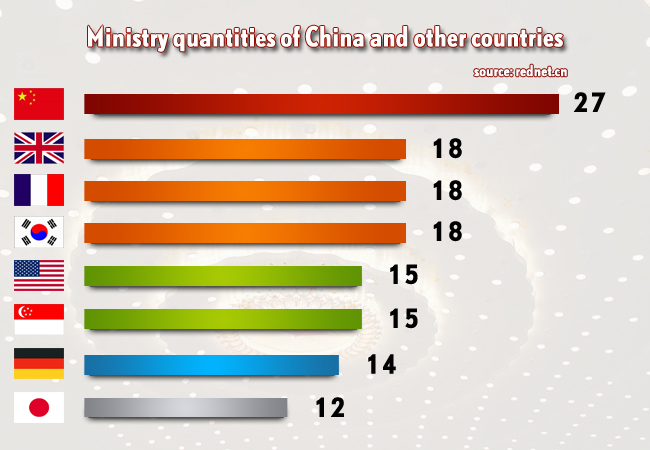HOME >> TWO SESSIONS 2013
China's cabinet to reform departmental system
Source:Globaltimes.cn Published: 2013-2-27 16:09:00
| Latest News |
Ministries face mashup
Institutional restructuring of the State Council is expected to top the agenda of the Second Plenum of the 18th Central Committee of the Communist Party of China (CPC) that kicked off Tuesday. Analysts suggested that boosting political and economic reforms are essential to transforming the government.
Highlights of the new round of institutional restructuring:
●Reinforcing market supervision
●Improving people’s livelihood
●Integrating and improving transportation management
Directions of the reforms:
●The efforts will be made to create a "simpler and decentralized administration".
●The institutional reform should be carried out in an "active yet prudent, step-by-step manner, with priority given to transformation of functions."
Possible operations:
●"Bigger" ministries with more comprehensive functions will be established to improve administration.
●Large-scale cuts and mergers are quite unlikely because the new leaders would prefer a steady transition that is not as fast as the public may expect.

| View Points |
Media Comments:
GT editorial: Judge reform by quality, not quantity
The assumption that bigger reforms are better is wrong. China needs to continue its institutional reforms, which will require efforts over several generations. Reforms cannot be stopped, but they also cannot be realized overnight.
Eastday.com: China's department structure cannot keep up with economic development
Commentator Bi Xiaozhe pointed out in an opinion piece on eastday.com that the institutional reforms should not simply cut or combine departments, but rather directly address the real reason behind the reforms – the structure in place cannot keep up with China’s rapid economic development.
Oriental Morning Post: The public should not expect the reforms to be completed anytime soon
Deng Yuwen, an expert on China's reforms and social transformation, echoed this opinion in the Shanghai-based Oriental Morning Post, saying that the public should not expect the government to complete the reforms anytime soon.
Qilu Evening News: The government should disclose information about the reforms to the public
The public knows very little about the draft, which may result in wild rumors and have a negative influence on society.
Weibo Voices:
@上海老顽童吴德余:The Ministry of Railways is now seemly an independent department. The high cost and fast development of high-speed rail construction has only brought us flimsy results. I wonder how the Ministry will be reformed this time around.
@郗昉:Reform should include reducing governmental interference in economy and society while cutting their authority and departmental benefits. Simply combining of departments is meaningless.
@周德文:I think the government should cut the number of civil servants employed, because the current administrative overhead is too much for tax bearers to bear.
| Background |
About "large government departments" reform
"Large government departments" reform refers to the restructuring of those governmental departments whose functions are similar or service scopes partly overlap. The departments will be uniformly gathered and operated by one department in order to avoid overlaps of government functions and management.
Reform Targets
●To raise effectiveness
●To cut administrative costs
●To transform governments’ functions
●To reduce market interference
Reform Approaches:
●Cut and merge redundant departments
●Separate governments and enterprises
Reform Timeline:
●In March 2008, the State Council restructured five ministries including the Ministry of Transport (MOT), which was dubbed as the first round of large-scale ministry reforms.
●In November 2012, the 18th Party congress again vowed in its report to steadily advance reforms to establish "larger government departments" as an important step to push forward general administrative system reform.
| Former Institutional Reforms |
| Round |
Time |
Reforms |
| 6 |
Mar. 2008 - present | ●Restructured five ministries including the Ministry of Transport, the Ministry of Industry and Information Technology, the Ministry of Human Resources and Social Security, the Ministry of Environmental Protection and the Ministry of Housing and Urban-Rural Development; ●Number of the departments of the State Council reduced from 28 to 27. |
| 5 |
Mar. 2003 - Mar. 2008 |
●Established Assets Supervision and Administration Commission of the State Council, China Banking Regulatory Commission, Ministry of Commerce, State Food and Drug Administration, and State Administration of Work Safety; ●Reorganized State Development Planning Commission to National Development and Reform Commission; ●Number of the departments of the State Council reduced from 29 to 28. |
| 4 |
Mar. 1998 – Mar. 2003 |
●Cut 15 departments; ●Added four ministries and commissions; changed the names of three ministries and commissions; ●Number of State Council departments (except General Office of the State Council ) cut to 29 from 40 |
| 3 |
Mar. 1993 – Mar. 1998 |
●Cut the number of State Council departments and institutions directly operated under the State Council from 86 to 59; ●Reduced the staff by 20 percent. |
| 2 |
Apr. 1988 – Mar. 1993 | ●Cut the number of State Council departments and commissions from 45 to 41; ●Cut 9,700 staff. |
| 1 |
Mar. 1982 – Apr. 1988 | ●Cut the number of State Council departments from 100 to 61; ●Reduced staff from 51,000 to 30,000. |

Posted in: GT Exclusive, Institutional Reform